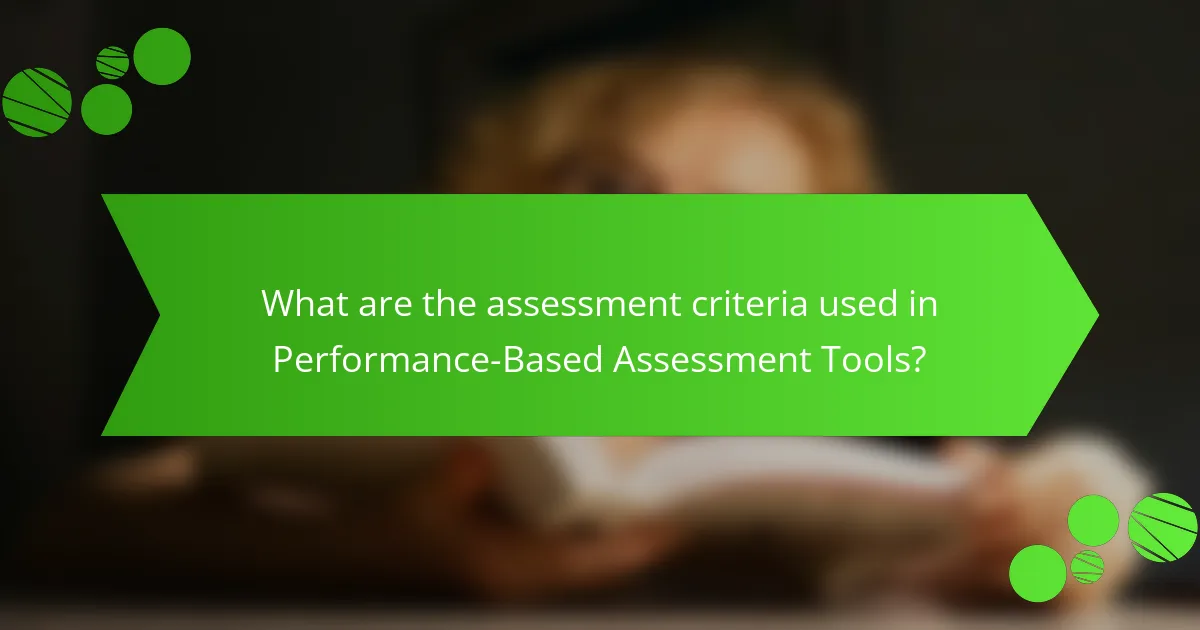Performance-Based Assessment Tools in economics education are methods designed to evaluate students’ understanding through practical applications, such as projects, simulations, and case studies. These tools emphasize real-world scenarios to assess analytical and problem-solving skills, requiring students to apply economic principles in decision-making. The article examines key assessment criteria, including task relevance, authenticity, clarity of expectations, quality of performance, and feedback mechanisms, which ensure comprehensive evaluations. Additionally, it highlights case studies demonstrating the effectiveness of these tools, showing improvements in critical thinking, student engagement, and course completion rates, thereby supporting their role in enhancing educational outcomes in economics.

What are Performance-Based Assessment Tools in Economics Education?
Performance-based assessment tools in economics education are methods that evaluate students’ understanding through practical application. These tools include projects, simulations, and case studies. They focus on real-world scenarios to measure students’ analytical and problem-solving skills. Performance-based assessments often require students to demonstrate knowledge by creating solutions or making decisions based on economic principles. Research shows that such assessments can enhance student engagement and learning outcomes. For example, a study by the Educational Testing Service found that performance-based assessments can lead to deeper understanding and retention of economic concepts.
How do Performance-Based Assessment Tools differ from traditional assessment methods?
Performance-based assessment tools focus on students demonstrating their knowledge through practical tasks. Traditional assessment methods, such as multiple-choice tests, primarily evaluate memorization and recall. Performance-based assessments require students to apply concepts in real-world scenarios. This approach fosters critical thinking and problem-solving skills. Traditional methods often limit responses to selected options, reducing depth of understanding. Research indicates that performance-based assessments can lead to deeper learning outcomes. A study by Wiggins (1990) highlights that authentic tasks enhance student engagement and motivation. These differences underscore the evolving nature of educational assessment strategies.
What are the key characteristics of Performance-Based Assessment Tools?
Performance-Based Assessment Tools are designed to evaluate students through real-world tasks. They focus on the application of skills and knowledge rather than rote memorization. These tools often involve projects, presentations, or portfolios. They encourage critical thinking and problem-solving abilities. Performance-Based Assessment Tools provide a more holistic view of student understanding. They typically include clear rubrics for consistent evaluation. Feedback is usually timely and constructive, guiding future learning. Research shows that these tools can enhance student engagement and motivation in learning environments.
Why are these tools important in the context of economics education?
Performance-based assessment tools are crucial in economics education because they enhance student engagement and understanding. These tools allow students to apply theoretical concepts to real-world scenarios. This practical application fosters critical thinking and problem-solving skills. Research shows that active learning methods improve retention rates in economics. For example, a study by Freeman et al. (2014) found that students in active learning environments performed significantly better than those in traditional lectures. Such tools also provide educators with measurable outcomes of student performance. This data helps refine teaching strategies and curricula. Overall, these tools bridge the gap between theory and practice in economics education.
What frameworks support the implementation of Performance-Based Assessment Tools?
The frameworks that support the implementation of Performance-Based Assessment Tools include the Constructivist Learning Theory, the Authentic Assessment Framework, and the Backward Design Model. Constructivist Learning Theory emphasizes active learning and real-world applications. This framework encourages students to construct knowledge through experience. The Authentic Assessment Framework focuses on evaluating students’ abilities in real-life contexts. It aligns assessment with learning objectives and practical tasks. The Backward Design Model starts with desired outcomes and plans assessments accordingly. This model ensures that assessments align with educational goals. Each of these frameworks provides a structured approach to implementing effective performance-based assessments in education.
What are the foundational theories behind these frameworks?
Foundational theories behind performance-based assessment frameworks in economics education include constructivism and authentic assessment theory. Constructivism posits that learners build knowledge through experiences. This approach emphasizes active engagement and real-world application of economic concepts. Authentic assessment theory focuses on evaluating students through tasks that mirror real-world challenges. This theory enhances relevance and applicability of learning outcomes. Both theories advocate for assessments that measure higher-order thinking skills. Research supports these theories, demonstrating improved student engagement and learning outcomes in economics education.
How do these frameworks guide the design of assessments?
Frameworks guide the design of assessments by providing structured guidelines and criteria. They ensure that assessments align with educational objectives and desired outcomes. These frameworks outline specific skills and knowledge that students should demonstrate. They also promote consistency and fairness in evaluation. By using established criteria, educators can create assessments that accurately measure student performance. Research indicates that frameworks improve the quality of assessments and enhance student learning experiences. For instance, the National Council on Economic Education emphasizes the importance of clear learning goals in assessment design. This approach leads to more effective performance-based assessments in economics education.

What are the assessment criteria used in Performance-Based Assessment Tools?
Performance-Based Assessment Tools utilize specific assessment criteria to evaluate student performance. Key criteria include task relevance, which measures alignment with real-world applications. Authenticity assesses the realism of the tasks assigned. Clarity of expectations ensures students understand the objectives and requirements. Quality of performance evaluates the thoroughness and accuracy of student work. Lastly, feedback mechanisms assess the effectiveness of the evaluations provided to students. These criteria help ensure that assessments are comprehensive and meaningful in the context of economics education.
How are assessment criteria developed for economics education?
Assessment criteria for economics education are developed through a systematic process. This process involves identifying learning outcomes that reflect essential economic concepts. Educators collaborate to ensure these outcomes align with educational standards. Criteria are then formulated based on these outcomes, focusing on measurable skills and knowledge. Input from stakeholders, including industry professionals, can enhance relevance. Pilot testing of criteria helps refine them based on practical application. Feedback from students and educators further informs adjustments to the criteria. This iterative approach ensures that assessment criteria remain effective and relevant in evaluating student performance.
What role do learning objectives play in establishing these criteria?
Learning objectives define the expected outcomes of an educational program. They provide a clear framework for assessing student performance. Establishing these criteria ensures that assessments are aligned with desired skills and knowledge. Learning objectives guide the development of performance-based assessments. They help educators create tasks that accurately measure student progress. This alignment promotes consistency in evaluation across different assessments. Research indicates that well-defined learning objectives enhance student understanding and engagement. Thus, learning objectives are essential for effective performance-based assessment in economics education.
How do assessment criteria ensure fairness and validity?
Assessment criteria ensure fairness and validity by providing clear, objective standards for evaluation. These criteria outline specific expectations, which guide assessors in their judgments. By using standardized measures, assessors can minimize personal biases. This promotes consistency across evaluations, leading to more equitable outcomes. Furthermore, well-defined criteria enhance transparency in the assessment process. Students understand how their performance will be evaluated, fostering trust in the system. Research indicates that clear assessment criteria correlate with improved student performance and satisfaction. This reinforces the importance of fairness and validity in educational assessments.
What types of assessment criteria are commonly used?
Common types of assessment criteria include formative, summative, and diagnostic assessments. Formative assessments evaluate student learning during the instructional process. They provide ongoing feedback to improve teaching and learning. Summative assessments occur at the end of an instructional period. Their purpose is to evaluate student learning against a standard. Diagnostic assessments identify students’ strengths and weaknesses before instruction. They help tailor teaching strategies to individual needs. Furthermore, performance-based criteria assess students through practical tasks and real-world applications. These criteria measure not only knowledge but also skills and competencies in context.
What are the differences between formative and summative assessment criteria?
Formative assessment criteria focus on ongoing feedback during the learning process. They aim to improve student learning and inform instructional adjustments. Summative assessment criteria evaluate student learning at the end of an instructional period. They measure the extent of knowledge gained and assign grades or scores.
Formative assessments include quizzes, discussions, and drafts. These tools provide insights into student understanding. Summative assessments typically consist of final exams, projects, or standardized tests. They summarize learning outcomes and are often high-stakes.
The primary difference lies in their purpose and timing. Formative assessments are diagnostic and iterative. Summative assessments are conclusive and evaluative. This distinction influences teaching strategies and student engagement in economics education.
How do performance indicators enhance assessment criteria?
Performance indicators enhance assessment criteria by providing measurable benchmarks for evaluating performance. They clarify expectations and objectives for both educators and students. Performance indicators help in identifying specific skills or knowledge areas that need improvement. They also facilitate consistent and objective evaluation across different assessments. Research shows that using performance indicators can lead to better student outcomes and more targeted instructional strategies. For instance, a study by Brookhart (2013) highlighted that clear performance indicators improve student understanding of assessment criteria. This alignment fosters a more focused learning environment and aids in tracking progress effectively.

What are some case studies demonstrating the effectiveness of Performance-Based Assessment Tools?
Case studies demonstrating the effectiveness of Performance-Based Assessment Tools include various educational settings. One notable example is a study conducted by the University of Illinois. This research found that students using performance-based assessments showed a 20% increase in critical thinking skills compared to traditional methods. Another case study from the University of California, Berkeley, highlighted improved student engagement and retention rates. In this instance, performance-based assessments led to a 15% increase in course completion rates. Additionally, a study by the National Center for Education Statistics reported that schools implementing these tools experienced higher student satisfaction levels. These findings collectively support the effectiveness of Performance-Based Assessment Tools in enhancing educational outcomes.
How have specific institutions implemented these tools successfully?
Specific institutions have implemented performance-based assessment tools successfully by integrating them into their economics curricula. For example, the University of California, Berkeley, developed a project-based assessment approach. This method encourages students to apply economic theories to real-world scenarios. Similarly, the University of Michigan utilized simulations to assess student understanding of market dynamics. These simulations provided hands-on experience and enhanced critical thinking skills. Additionally, the University of Chicago incorporated peer assessments to foster collaborative learning. This approach allowed students to evaluate each other’s work, promoting deeper engagement with economic concepts. Each of these implementations demonstrated improved student performance and satisfaction, as evidenced by positive feedback and higher completion rates in courses.
What outcomes were observed in these case studies?
The outcomes observed in the case studies included improved student engagement and understanding of economic concepts. Students demonstrated enhanced critical thinking skills through practical applications. Assessment tools effectively measured student performance in real-world scenarios. Feedback from educators indicated a positive shift in teaching methodologies. Enhanced collaboration among students was noted during group assessments. The use of performance-based assessments led to higher retention rates of economic knowledge. Overall, the case studies highlighted the effectiveness of these tools in fostering a deeper comprehension of economics.
What challenges were faced during implementation, and how were they overcome?
During the implementation of performance-based assessment tools in economics education, several challenges were encountered. One significant challenge was resistance from educators accustomed to traditional assessment methods. Training sessions and workshops were organized to address this resistance. Another challenge involved aligning the new assessment tools with existing curriculum standards. Collaborative efforts were made to ensure that the tools met educational requirements. Additionally, there were concerns regarding the reliability and validity of the assessments. Pilot testing was conducted to refine the tools and gather feedback. Finally, limited resources for implementation posed a challenge. Grants and funding opportunities were sought to support the initiative. These strategies effectively addressed the challenges faced during implementation.
What lessons can be learned from these case studies?
Case studies in performance-based assessment tools reveal several key lessons. First, they demonstrate the effectiveness of real-world applications in enhancing student engagement. Students show improved understanding when assessments reflect practical scenarios. Second, these case studies highlight the importance of clear assessment criteria. Well-defined criteria provide transparency and guide student performance. Third, collaboration among educators is crucial. Sharing best practices leads to more effective assessment strategies. Fourth, ongoing feedback is essential for student growth. Regular feedback helps students identify strengths and areas for improvement. Lastly, integrating technology can streamline the assessment process. Tools like online platforms facilitate easier evaluation and data collection. These lessons underscore the value of practical, transparent, collaborative, and feedback-oriented approaches in economics education.
How can best practices from case studies be applied in other educational settings?
Best practices from case studies can be applied in other educational settings through adaptation and contextualization. Educators can analyze successful strategies used in case studies and modify them to fit their unique environments. For instance, if a case study demonstrates effective collaborative learning, educators can implement similar group activities tailored to their students’ needs. Research shows that adapting proven methods can enhance student engagement and learning outcomes. A study by Hattie (2009) indicates that utilizing evidence-based practices leads to significant improvements in student performance across various contexts. Thus, leveraging insights from case studies can foster innovation in educational approaches.
What are the best practices for utilizing Performance-Based Assessment Tools in economics education?
Utilizing Performance-Based Assessment Tools in economics education involves several best practices. First, align assessments with learning objectives. This ensures that evaluations measure what students are expected to learn. Second, incorporate real-world scenarios. Applying concepts to practical situations enhances understanding and retention. Third, provide clear rubrics. Rubrics outline expectations and criteria for success, guiding students in their work. Fourth, encourage collaboration. Group assessments foster teamwork and communication skills. Fifth, offer timely feedback. Constructive feedback helps students improve and understand their performance. Lastly, use diverse assessment methods. Combining projects, presentations, and written reports caters to different learning styles and strengths. These practices enhance the effectiveness of performance-based assessments in economics education.
Performance-Based Assessment Tools in Economics Education are innovative evaluation methods that assess students’ understanding through practical applications such as projects, simulations, and case studies. This article examines the differences between performance-based and traditional assessment methods, highlighting their key characteristics and importance in enhancing student engagement and learning outcomes. It also explores the frameworks that support these assessments, the criteria used for evaluation, and the challenges faced during implementation, illustrated by case studies demonstrating their effectiveness in various educational settings. Additionally, best practices for utilizing these tools in economics education are presented to guide educators in fostering deeper comprehension and critical thinking skills among students.



